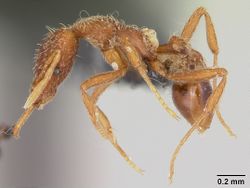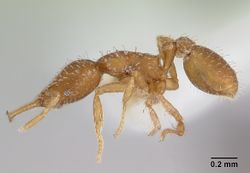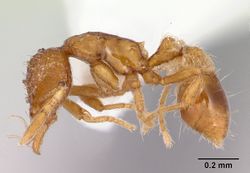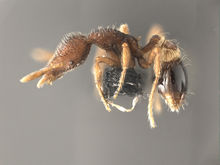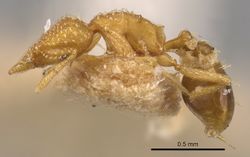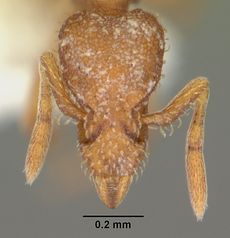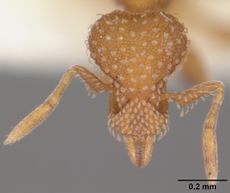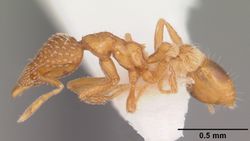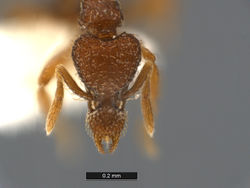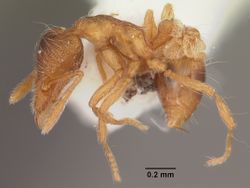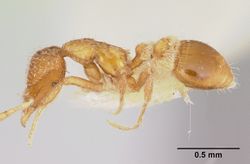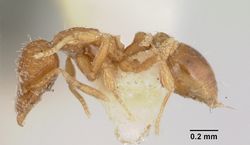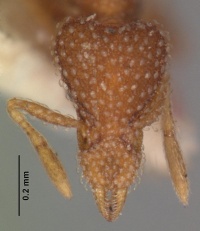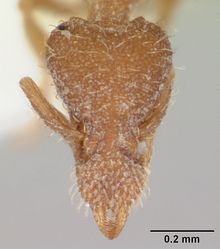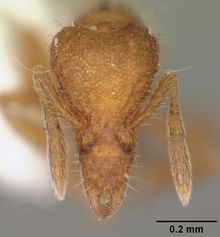Key to US Strumigenys species
This key to Strumigenys species known from the United States is loosely based on Bolton (2000). It merges his Pyramica and Strumigenys keys with additions to accommodate recently described species.
The suspected social parasite Strumigenys inopina, known only from queens and with an unknown host, and the queen-based Strumigenys subnuda, are omitted from the key. The recently described species Strumigenys ananeotes, from Utah, has yet to be added to this key.
1
- Mandibles narrow and elongate, sublinear to linear in full-face view; in this view and at full closure the mandibles engage only in the apical third or less of their length, MI 25-67 . . . . . 1A
- Mandibles triangular to elongate-triangular in full-face view; in this view and at full closure the mandibles engage through the apical half or more of their length, at most with a basal gap, MI 11-25 . . . . . 6
1A
- Antenna with 4 segments; the first funicular segment followed directly by the 2-segmented club . . . . . Strumigenys emmae
- Antenna with 5 or usually 6 segments; the first funicular segment separated from the 2-segmented club rarely by one, usually by two, much smaller segments . . . . . 2
2
return to couplet #1
- Petiole in profile with a conspicuous ventral crest or curtain of spongiform tissue. . . . . . 3
- Petiole in profile without spongiform tissue ventrally. . . . . . 5
3
- Hairs on front of head thin and elongate . . . . . 3A
- Hairs on front of head short and moderately to greatly expanded (spatulate) . . . . . 3B
3A
- Mandibles without intercalary teeth or denticles that arise between apicodorsal and apicoventral teeth of apical fork, nor arise from dorsal base of apicoventral tooth . . . . . Strumigenys rogeri
- Mandible with 1 or 2 intercalary teeth or denticles that arise between apicodorsal and apicoventral teeth of apical fork, or arise from dorsal base of apicoventral tooth . . . . . 3D
3D
- Dorsal surface of gaster with a few widely scattered more or less straight erect hairs ...... Strumigenys godeffroyi
- Dorsal surface of gaster with numerous very long, wavy erect hairs . . . . . Strumigenys lanuginosa
3B
- Mandible elongate and linear, teeth restricted to near tip . . . . . Strumigenys nevermanni
- Mandible shorter and weakly to moderately convex, teeth found along at least half of length . . . . . 3C
3C
- With head in full-face view and mandibles fully closed only 3 teeth visible: 2 small preapical teeth and an extremely long apicodorsal tooth that completely crosses over the tooth from the opposite mandible and projects beyond the outer margin of the opposite mandible. Leading edge of scape with all hairs curved toward the scape apex. Dorsal (outer) surface of hind basitarsus without projecting flagellate hairs. Scape relatively short and head broad, SI < 55, CI 100 or more . . . . . Strumigenys hexamera
- With head in full-face view and mandibles fully closed numerous small teeth and denticles visible; without an extremely long apicodorsal tooth that completely crosses over the tooth from the opposite mandible and projects beyond the outer margin of the opposite mandible. Leading edge of scape with one or more hairs that are curved toward the scape base. Dorsal (outer) surface of hind basitarsus with 1-3 freely projecting fine flagellate hairs. Scape relatively long and head narrow, SI > 60, CI 68-79 . . . . . 4
4
return to couplet #3
- Basal and two succeeding teeth on mandible triangular and acute, the second tooth longer than the basal. Disc of postpetiole without posteriorly curved spatulate hairs. Dorsum of mesonotum with a pair of erect simple hairs. Anterior and lateral margins of clypeus meet in angular comers in full-face view. Scape relatively short, SI 65-69. . . . . . Strumigenys angulata
- Basal and third tooth on mandible triangular and acute, second tooth broad and bluntly rounded; basal longer than second or third teeth. Disc of postpetiole with posteriorly curved spatulate hairs. Dorsum of mesonotum without erect simple hairs. Anterior and lateral margins of clypeus meet through rounded curves in full-face view. Scape relatively long, SI 79-84. . . . . . Strumigenys pergandei
5
- Leading edge of scape with all hairs curved or inclined toward the apex of the scape; without hairs that curve toward the base of the scape, without a series of hairs at right-angles to the long axis of the scape shaft . . . . . Strumigenys boneti
- Leading edge of scape either with one to many hairs that distinctly curve toward the base of the scape, or rarely with hairs that are at right-angles to the long axis of the scape shaft; never with all hairs obviously curved or inclined toward the apex of the scape . . . . . 5A
5A
- Postpetiole in profile with the ventral spongiform lobe absent or reduced to a minute nonspongiform vestige . . . . . Strumigenys eggersi
- Postpetiole in profile with the ventral spongiform lobe present, small but distinct . . . . . 5B
5B
- Hairs on front of head flattened and expanded, their tips blunt to broadly convex . . . . . . . Strumigenys louisianae
- Hairs on front of head narrow and elongate, their tips acute. . . . . 5C
5C
- Sides of head uniformly convex; mandible with a single elongate preapical tooth . . . . . Strumigenys silvestrii
- Sides of head angular; mandible with several short preapical teeth . . . . . . Strumigenys gundlachi
6
return to couplet #1
- Petiole ventrally without trace of spongiform tissue. Pleurae, side of propodeum and disc of postpetiole reticulate-punctate. First gastral tergite finely and densely triolate-punctulate everywhere; first gastral sternite finely shagreenate or punctulate at least basally and laterally. . . . . . Strumigenys margaritae
- Petiole ventrally with a conspicuous spongiform crest or curtain. Pleurae, side of propodeum and disc of postpetiole generally smooth (punctate in one species). First gastral tergite smooth behind the basigastral costulae, usually entirely smooth but rarely with some sculpture near apex; first gastral sternite unsculptured or with sculpture only near apex . . . . . 7
7
return to couplet #6
- Clypeus in anterior view with an apicodorsal series of 4-6 stout standing long hairs that radiate from the apex like the ribs of a fan. In profile clypeal dorsum with a pair of very long wire-like hairs that arise at about the midlength; each of these hairs is inclined posteriorly from just above its base, then curves smoothly upwards so that at least the apical half of the shaft is directed vertically or nearly so . . . . . 8
- Clypeus in anterior view without an apicodorsal series of stout standing long hairs that radiate like the ribs of a fan. In profile clypeal dorsum without long wire-like hairs arising at about the midlength; without hairs that incline posteriorly from just above the base then curve vertically . . . . . 9
8
return to couplet #7
- Fan of long hairs that radiates from clypeus apicodorsally strongly bulbous at their apices; in profile these bulbous-tipped hairs distinctly curved posteriorly. . . . . . Strumigenys ornata
- Fan of long hairs that radiates from clypeus apicodorsally simple at their apices; in profile these hairs not obviously curved posteriorly . . . . . 8A
8A
- Six radiating subapical setae on clypeus. Jaws protruding further beyond clypeus, diastemma clearly visible in frontal view. Sides of pronotum reticulate . . . . . . Strumigenys dietrichi
- Four radiating subapical setae on clypeus. Jaws protruding only a short distance beyond clypeus, diastemma barely visible in frontal view. Sides of pronotum primarily shiny . . . . . Strumigenys boltoni
9
return to couplet #7
- With head in full-face view and mandibles fully closed the masticatory margin without a distinct diastema basally. If basal lamella is concealed by clypeus at full closure then gap between basal tooth and anterior margin of clypeus is shorter than length of basal tooth. If basal lamella is exposed at full closure then diastema between basal tooth and basal lamella is absent or distinctly shorter than length of basal tooth . . . . . 10
- With head in full-face view and mandibles fully closed the masticatory margin with a distinct diastema basally. If basal lamella is concealed by clypeus at full closure then gap between basal tooth and anterior margin of clypeus is greater than length of basal tooth. If basal lamella is exposed at full closure then diastema between basal tooth and basal lamella is distinctly longer than length of basal tooth . . . . . 21
10
return to couplet #9
- Dorsal surface of fully closed mandible basally with a very distinct sharp transverse edge or rim running across the width of the blade, parallel to and in front of the anterior clypeal margin. Pronotum sharply marginate dorsolaterally, the dorsum transversely flattened and unsculptured. First gastral tergite without standing hairs of any form. (Cosmopolitan tramp species) . . . . . Strumigenys membranifera
- Dorsal surface of fully closed mandible basally without a transverse edge or rim running across the width of the blade parallel to the anterior clypeal margin. Pronotum not marginate dorsolaterally, the dorsum transversely convex and sculptured. First gastral tergite with standing hairs of some form present. . . . . . 11
11
return to couplet #10
- With head in full-face view hairs that project from the lateral clypeal margin fine, conspicuously J-shaped and curved posteriorly. . . . . . Strumigenys pilinasis
- With head in full-face view hairs that project from the lateral clypeal margin variable in form but not J-shaped and curved or inclined anteriorly . . . . . 12
12
return to couplet #11
- Leading edge of scape with a row of conspicuous projecting curved hairs of which one or more, distal to the subbasal bend, distinctly curves toward the base of the scape . . . . . 13
- Leading edge of scape with all projecting hairs curved toward the apex of the scape; entirely lacking hairs that curve toward the base of the scape . . . . . 17
13
return to couplet #12
- Apical portion of first gastral tergite subopaque, densely sculptured with fine reticulation and striolation; same area on first gastral sternite similarly sculptured. Propodeal dorsum predominantly smooth and shining. . . . . . Strumigenys californica
- Apical portions of first gastral tergite and sternite smooth and shining, without reticulate or striolate sculpture. Propodeal dorsum punctate to reticulate-punctate . . . . . 13A
13A
- In dorsal view pronotum with a curved row of spoon-shaped hairs. . . . . . . Strumigenys epinotalis
- In dorsal view the pronotum either lacking spoon-shaped hairs or, when present, hairs scattered across the surface and not forming a curved row . . . . . 14
14
return to couplet #13
- Basal lamella of mandible followed immediately by a row of 7 coarse conical teeth, without trace of a diastema. Anterior clypeal margin shallowly concave. Dorsum of head close to occipital margin with a transverse row of 4 hairs that are differentiated from the ground-pilosity, being longer, more erect and more slender. With head in full-face view an apicoscrobal hair present, stout simple and curved anteriorly. . . . . . Strumigenys rostrata
- Basal lamella of mandible followed by a small diastema (distinctly shorter than length of basal tooth), distal to which is a row of 5 small acute teeth. Anterior clypeal margin transverse to shallowly convex. Dorsum of head close to occipital margin without slender hairs that are differentiated from the ground-pilosity. With head in full-face view apicoscrobal hair absent. . . . . . 15
15
return to couplet #14
- Lateral spongiform lobe of postpetiole small, in profile its area less than that of the exposed cuticle of the disc. In dorsal view postpetiole disc with sides only very thinly margined by spongiform tissue; maximum width across the spongiform tissue only ca. 1. 3 times the diameter of the disc. Maximum depth of ventral spongiform curtain of petiole narrower than height of peduncle. . . . . . Strumigenys arizonica
- Lateral spongiform lobe of postpetiole massive, in profile its area distinctly greater than that of the exposed cuticle of the disc. In dorsal view postpetiole disc with sides thickly surrounded by spongiform tissue; maximum width across the spongiform tissue almost twice the diameter of the disc. Maximum depth of ventral spongiform curtain of petiole deeper than height of peduncle . . . . . 16
16
return to couplet #15
- Mesonotum without a pair of long flagellate hairs. Dorsum of pronotum and mesonotum evenly reticulate-punctate, sculpture on the two not contrasting. Pronotum without a median longitudinal carina. MI 16-20, CI 64-69. . . . . . Strumigenys bunki
- Mesonotum with a pair of long flagellate hairs. Dorsum of pronotum indistinctly shallowly striolate, mesonotum reticulate-punctate, the two contrasting. Pronotum with a median longitudinal carina. MI 22-25, CI 71-75. . . . . . Strumigenys carolinensis
17
return to couplet #12
- With head in full-face view and mandibles fully closed the basal lamella mostly exposed, occupying at least the basal third of the exposed length of the margin; exposed length of basal lamella at least equal to length of margin occupied by the basal 4 teeth together. On mandible second tooth from base the longest. . . . . . Strumigenys archboldi
- With head in full-face view and mandibles fully closed the basal lamella mostly or entirely concealed, occupying at most the extreme base of the exposed length of the margin; exposed length of basal lamella far less than length of margin occupied by the basal 4 teeth together. On mandible third tooth from base the longest. . . . . . 18
18
return to couplet #17
- Dorsum of clypeus with dense short broadly oval-spatulate to scale-like hairs; in profile these hairs reclinate to appressed. In full-face view hairs that project from the lateral clypeal outline either scale-like and appressed to the margin or broadly spatulate and strongly curved anteriorly . . . . . 19
- Dorsum of clypeus with elongate narrow hairs that are simple, somewhat flattened or very narrowly linear-spatulate; in profile these hairs not appressed, either elevated and inclined anteriorly or curving anteriorly in their apical halves. In full-face view hairs that project from the lateral clypeal outline either fine and simple or narrow and linear-spatulate, inclined anteriorly, only very weakly curved or more or less straight. . . . . . 20
19
return to couplet #17
- With head in full-face view hairs on lateral clypeal margin project and are curved anteriorly, not appressed to the surface, distinctly longer and broader than the hairs on the clypeal dorsum. Upper scrobe margin with 1-2 laterally projecting long flagellate hairs. In profile flagellate hairs present on cephalic dorsum behind highest point of vertex. . . . . . Strumigenys clypeata
- With head in full-face view hairs on lateral clypeal margin scale-like and closely appressed to the surface, no longer or broader than the hairs on the clypeal dorsum. Upper scrobe margin without flagellate hairs. In profile cephalic dorsum without flagellate hairs. . . . . . Strumigenys rohweri
20
return to couplet #17
- Clypeal pilosity everywhere very fine and filiform, acute apically. In full-face view hairs that project from lateral margin of clypeus the same shape and about the same length as-those arising mid-dorsally. In profile hairs on clypeal mid-dorsum elevated and inclined anteriorly. . . . . . Strumigenys laevinasis
- Clypeal pilosity everywhere narrowly linear-spatulate or flattened and spatulate in the apical half and truncated apically. In full-face view hairs that project from lateral margin of clypeus of different shape and longer than those arising mid-dorsally. In profile hairs on clypeal mid-dorsum curved or arched anteriorly. . . . . . Strumigenys pilinasis
21
return to couplet #9
- Principal basal dental row of mandible with 5 teeth followed distally by 2 smaller teeth; counting from the base tooth 3 the longest . . . . . 22
- Principal basal dental row of mandible with 4 teeth followed distally by 2 smaller teeth; counting from the base tooth 3 not the longest . . . . . 27
22
return to couplet #21
- Clypeal margin anteriorly and laterally with a continuous broad groove around the periphery. In profile the clypeal edge with a distinct dorsal border and a more strongly prominent ventral border, the two separated by the evenly concave peripheral groove. In full-face view both borders visible and concentric as the lower projects beyond the upper . . . . . 23
- Clypeal margin anteriorly and laterally without a continuous groove around the periphery. In profile the clypeal edge thick or thin but single, without upper and lower borders separated by a concave peripheral groove. In full-face view the margin simple, without two visible concentric borders . . . . . 24
23
return to couplet #22
- With clypeus in profile a very long erect flagellate hair arises from the dorsum just in front of the antennal socket; this hair much longer than any others on the dorsum. Dorsolateral margin of head with 2 pairs of flagellate hairs and cephalic dorsum with a flagellate pair close to the occipital margin. . . . . . Strumigenys filirrhina
- With clypeus in profile the dorsum with short curved non-flagellate hairs only, without a very long erect flagellate hair arising just in front of the antennal socket. Dorsolateral margin and dorsum of head without flagellate hairs. . . . . . Strumigenys bimarginata
24
return to couplet #22
- Hairs on dorsum and margins of clypeus all very fine, filiform and acute apically; clypeus entirely lacking spatulate or spoon-shaped hairs. . . . . . Strumigenys reliquia
- Hairs on dorsum and margins of clypeus mostly or entirely spatulate or spoon-shaped; clypeus entirely lacking fine filiform hairs . . . . . 25
25
return to couplet #24
- All hairs on leading edge of scape curved or inclined toward the apex of the scape. Upper scrobe margin with 2-3 laterally projecting long flagellate hairs, one apicoscrobal and 1-2 anterior to this. . . . . . Strumigenys clypeata
- Two or more hairs on leading edge of scape curved toward the base of the scape. Upper scrobe margin with a single laterally projecting long flagellate hair, in apicoscrobal position . . . . . 26
26
return to couplet #25
- First (basal) tooth on mandible distinctly shorter than second. Clypeal dorsum with short spatulate hairs that are not translucent. With gaster in dorsal view longest basigastral costulae posterior to line of limbus at least as long as postpetiole disc and mostly longer . . . . . Strumigenys chiricahua
- First (basal) tooth on mandible distinctly longer than second. Clypeal dorsum with fully translucent large spoon-shaped hairs. With gaster in dorsal view longest basigastral costulae posterior to line of limbus much shorter than postpetiole disc. . . . . . Strumigenys hyalina
27
return to couplet #21
- Leading edge of scape with two or more of the principal hairs curved or inclined toward the base of the scape . . . . . 28
- Leading edge of scape with all hairs curved or inclined toward the apex of the scape . . . . . 37
28
return to couplet #27
- All hairs on clypeus, including those on margins as well as those on dorsum, very fine, slender and simple, acute apically. . . . . . Strumigenys filitalpa

- Some or all clypeal hairs spatulate, clavate, spoon-shaped or otherwise bizarre; clypeal hairs not entirely very fine slender and simple . . . . . 29
29
return to couplet #28
- In full-face view hairs on lateral clypeal margin curved anteriorly and hairs on anterior clypeal margin either curved toward the midline or directed anteriorly. Entirety of clypeal margin without any hairs that are curved away from the midline, inclined or curved outwards, or curved posterolaterally . . . . . 30
- In full-face view at least one pair of hairs on clypeal margin curved away from the midline, or inclined or curved outward, or curved posterolaterally. Hairs so oriented may occur on lateral margins but at least a single pair, on the anterior margin close to midline, curved away from the midline . . . . . 33
30
return to couplet #29
- Pronotal humeral hair absent. With head in full-face view upper scrobe margin without a laterally projecting elongate filiform or flagellate hair. . . . . . Strumigenys creightoni
- Pronotal humeral hair present, filiform or flagellate. With head in full-face view upper scrobe margin usually with a laterally projecting filiform or flagellate hair just behind level of eye or close to apex of scrobe . . . . . 31
31
return to couplet #30
- With head in full-face view entire dorsum of clypeus densely clothed with very conspicuous broadly spatulate hairs, those located mid-dorsally only slightly shorter and narrower than those that fringe the lateral clypeal margin. Slightly larger species, HW 0.40-0.43. . . . . . Strumigenys abdita
- With head in full-face view dorsum of clypeus equipped with small narrowly spatulate hairs, those located mid-dorsally tiny, much smaller and narrower than the large curved hairs that fringe the lateral clypeal margin. Slightly smaller species, HW 0.33-0.38 . . . . . 32
32
return to couplet #31
- Pair of standing long hairs on dorsum of pronotum, pair on mesonotum and hairs on first gastral tergite filiform and feebly curved, not flagellate. With petiole in profile maximum depth of ventral spongiform curtain less than maximum depth of peduncle. Head slightly broader, CI 69-74 . . . . . Strumigenys metazytes
- Pair of standing long hairs on dorsum of pronotum, pair on mesonotum and hairs on first gastral tergite distinctly flagellate. With petiole in profile maximum depth of ventral spongiform curtain greater than maximum depth of peduncle. Head slightly narrower, CI 63-65 . . . . . Strumigenys talpa
33
return to couplet #29
- Pronotal humeral hair present. Dorsal (outer) surface of hind tibia, basitarsus, or both with 1-2 long fine flagellate hairs; tibia without suberect hairs . . . . . 34
- Pronotal humeral hair absent. Dorsal (outer) surface of hind tibia and basitarsus without long fine flagellate hairs; tibia with short suberect hairs . . . . . Strumigenys memorialis
34
return to couplet #33
- With clypeus in full-face view laterally or posteriorly curved marginal hairs restricted to 1-2 pairs situated on the anterior margin above the mandibles; hairs on lateral margins not all curved posteriorly . . . . . 35
- With clypeus in full-face view laterally or posteriorly curved marginal hairs present on the anterior margin above the mandibles; all hairs posteriorly curved on the lateral margins. . . . . . Strumigenys reflexa
35
return to couplet #34
- Hairs that project from lateral margin of clypeus thick and simple, sparse, not strongly curved anteriorly nor forming a regular fringe. With head in full-face view clypeus slightly longer than broad; with mandibles fully closed the lateral clypeal margin continuing the line of the outer margin of the mandible . . . . . Strumigenys cloydi
- Hairs that project from lateral margin of clypeus broadly spatulate to spoon-shaped, most or all strongly curved anteriorly, usually forming a regular fringe. With head in full-face view clypeus distinctly broader than long; with mandibles fully closed the lateral clypeal margin extending far outside the line of the outer margin of the mandible . . . . . 36
36
return to couplet #35
- With head in full-face view a flagellate apicoscrobal hair absent. Pronotal humeral hair simple, stiff and stout. Mesonotum with erect stout simple hairs. Head broader and scapes shorter, CI 68-72, SI 69-75. . . . . . Strumigenys missouriensis
- With head in full-face view a flagellate apicoscrobal hair present. Pronotal humeral hair flagellate, elongate and fine. Mesonotum with a single pair of erect fine flagellate hairs. Head narrower and scapes longer, CI 61-66, SI 78-82. . . . . . Strumigenys pulchella
37
return to couplet #27
- Some or all hairs on dorsum of clypeus curved or inclined posteriorly or posterolaterally . . . . . 38
- All hairs on dorsum of clypeus curved or inclined anteriorly or anterolaterally . . . . . 39
38
return to couplet #37
- Lateral clypeal margin with obviously spatulate or spoon-shaped curved hairs. With head in full-face view clypeus broader than long; with mandibles fully closed the lateral clypeal margin extending well beyond the the line of the outer margin of the mandible. Anterior tip of clypeus not curving upward away from the dorsal surface of the mandible. CI 66-70, SI 70-74. . . . . . Strumigenys wrayi
- Lateral clypeal margin with stiff elongate hairs that are thickened apically but obviously are not spatulate or spoon-shaped. With head in full-face view clypeus slightly longer than broad; with mandibles fully closed the lateral clypeal margin continuing the line of the outer margin of the mandible. Anterior tip of clypeus feebly curving upward away from the dorsal surface of the mandible. CI 60-64, SI 79-83. . . . . . Strumigenys cloydi
39
return to couplet #37
- Dorsolateral margin of head with two freely projecting long flagellate hairs. Anteriorly curved hairs that fringe the lateral clypeal margins very soft and weak, filiform. Hairs on clypeal dorsum very slender, simple and acute. . . . . . Strumigenys filitalpa

- Dorsolateral margin of head with a single freely projecting long flagellate hair. . . . . . 39A
39A
- Anteriorly curved hairs that fringe the lateral clypeal margins strong, linear-spatulate to weakly spoon-shaped. Hairs on clypeal dorsum spatulate. . . . . . Strumigenys talpa
- Clypeal hairs thin, not spatulate or spoon-shaped . . . . . Strumigenys apalachicolensis





